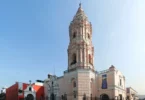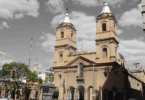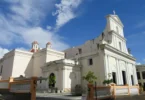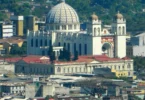Introduction
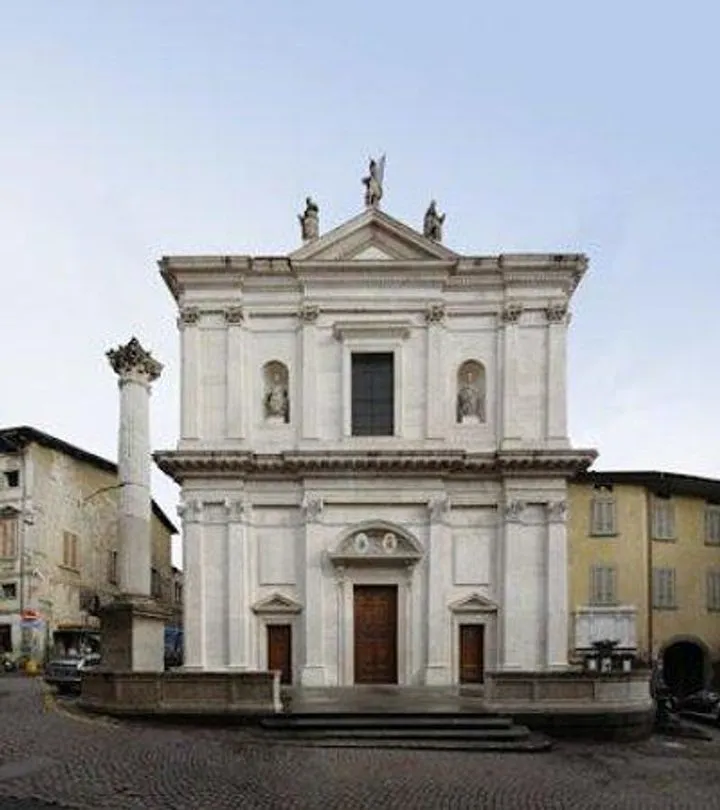
The Basilica of Sant’Alessandro in Colonna stands as one of the most significant sites of Catholic worship in the city of Bergamo, situated in the heart of the Lower Town (Città Bassa). Revered not only for its architectural beauty but also for its deep historical and spiritual roots, the basilica is believed to mark the exact location where Saint Alexander, the patron saint of Bergamo, was martyred. According to long-standing tradition, it was here—on this sacred ground—that Alexander, a soldier of the Theban Legion who refused to renounce his Christian faith, met his death during the Roman persecutions. Over the centuries, this site became a focal point of veneration and devotion, eventually giving rise to a church that would be transformed and rebuilt through various periods of history. Today, the basilica remains a cherished religious and cultural landmark, blending centuries of faith, artistic expression, and local identity into a single enduring monument dedicated to the city’s beloved saint.

The Basilica of Sant’Alessandro in Colonna has its roots in the early centuries of Christianity, and its foundation is intimately connected with the martyrdom of Saint Alexander of Bergamo, the city’s patron saint. Tradition holds that the church was established on the very site where the saint was executed for his Christian faith. This deep historical and spiritual association has made the basilica a lasting symbol of religious devotion in Bergamo. The earliest recorded mention of the church dates back to the year 1133, confirming the presence of a sacred structure on this site during the Middle Ages. However, following a partial collapse of the original building, a comprehensive reconstruction began in 1447, which led to the church’s rededication and consecration on 22 October 1474 by Bishop Lodovico Donà of Bergamo.
In the early 18th century, the church underwent another significant transformation, this time led by architect Marco Alessandri. This renovation aligned with the architectural ideals of the Counter-Reformation, favoring a more unified and didactic interior to enhance the spiritual experience of the faithful. While the redesign brought cohesion to the church’s form and function, it also resulted in the loss of valuable earlier elements, such as the Chapel of the Santissimo Corpo di Cristo, originally designed in 1511 by Pietro Isabello. Only the stone pillars of this Renaissance masterpiece remain today, absorbed into the newer Baroque structure.
At the front of the church, the churchyard features a historic column known as the Colonna del Crotacio, traditionally believed to mark the very spot of Saint Alexander’s martyrdom. The column, reassembled in 1618 using ancient Roman fragments, has long been a point of local veneration. The name “Crotacio” is believed to derive from a Roman funerary monument, possibly dedicated to an individual named Crotacio and once topped with a pagan statue. Interestingly, the street on which the church is located was originally called Vico Crotacio, only taking on the name of Saint Alexander after the year 1000. The final architectural addition to the basilica was the bell tower, completed in 1905 to a design by Giuseppe Bovara, realized by Virginio Muzio. The tower, accessible via 126 steps, culminates in a platform that holds a majestic statue of the Madonna del Patrocinio, watching over the city and further elevating the church’s symbolic presence in Bergamo’s skyline.
Architecture of Basilica of Sant'Alessandro in Colonna, Bergamo, Italy
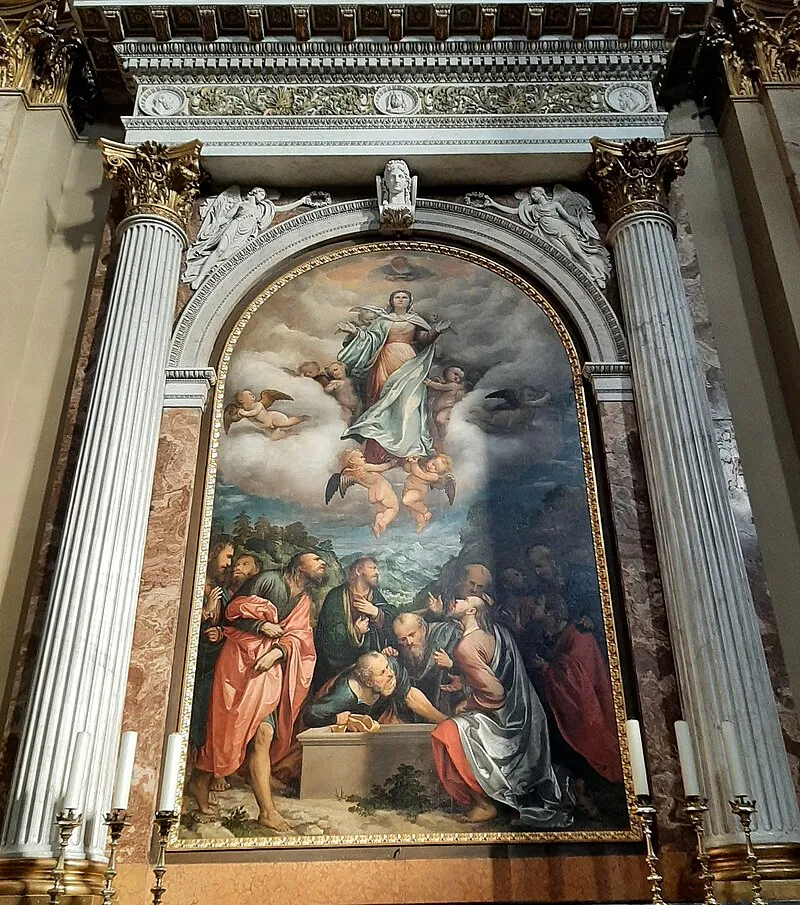
Architectural Style: Baroque architecture.
Facade and Architectural Composition
The façade of the Basilica of Sant’Alessandro in Colonna presents a harmonious blend of Neoclassical elegance and religious symbolism. Constructed from refined Botticino marble, it is carefully articulated into two horizontal levels, or orders, separated by a finely serrated cornice. Four vertical pilasters divide the surface into distinct sections, each crowned with elaborate Corinthian capitals, lending a sense of rhythm and classical grandeur to the structure. The lower section features three entrances. The central portal is the most elaborate, with a sculpted marble frame supported by ornamental brackets that uphold an arched tympanum. This main doorway is flanked by two secondary entrances, each framed by stone pilasters and topped with triangular pediments, providing architectural balance and symmetry.
The upper order continues the decorative theme. A large arched window dominates the center, framed with a molded stone cornice and allowing light to enter the interior nave. On either side, niches house statues of saints, adding depth and spiritual character to the façade. Crowning the entire structure is a prominent triangular tympanum adorned with three statues, visually and symbolically emphasizing the sacred purpose of the basilica. Together, these elements form a cohesive and stately exterior that reflects the historical and religious importance of the site.
Crotacio’s Column
Positioned in the churchyard, the Colonna del Crotacio is a deeply symbolic and historic monument. Tradition holds that it marks the site of Saint Alexander’s martyrdom. The name “Crotacio” derives from a Roman figure believed to have lived in Bergamo during the 3rd century. He was possibly the grandfather of Saint Grata, the noblewoman who famously retrieved the severed head of Saint Alexander. Some accounts suggest that Crotacio was a soldier who gave refuge to the saint during his flight. Following his death, Crotacio’s son Lupo erected a memorial by stacking two Corinthian columns, each adorned with acanthus leaves, and crowned the monument with a pagan statue—which stood until at least the year 1000. The first historical mention of the column comes from 1133, when the area and the church were described as “in columna,” referring to its proximity to this ancient structure.
During his 1575 pastoral visit, Saint Charles Borromeo acknowledged the column as the martyrdom site and recommended enclosing it with a protective fence—a request that was never fulfilled. By the early 17th century, the original column had deteriorated and was reconstructed in 1618 under Bishop Giovanni Emo, using both original Roman pieces and newer additions. Scholarly analysis indicates that the upper three sections of the column are original Roman fragments, while the two lower sections were crafted in the 17th century. The capital was produced by Domenico Fantone, a noted local stonemason.
The Bell Tower
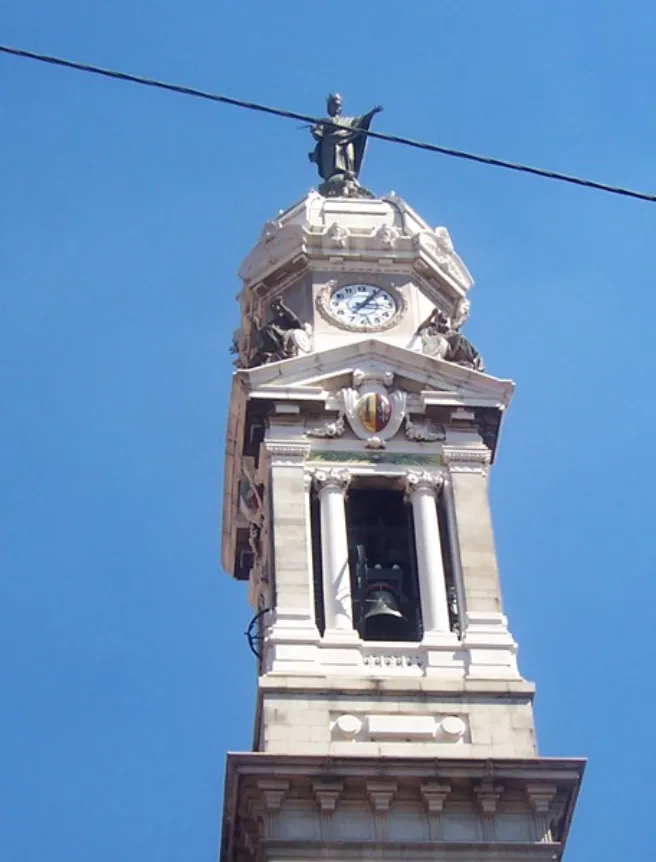
The bell tower of the Basilica of Sant’Alessandro in Colonna rises as a striking landmark in the Bergamo skyline, though it was not part of the church’s original medieval or Renaissance construction. The idea to erect a proper campanile emerged in 1842, with the initial plans drawn up by architect Giovanni Bovara. However, the construction faced numerous interruptions and delays, and it wasn’t until 1904 that the tower was finally completed, this time following a revised design by architect Virginio Muzio.
Architecturally, the bell tower is composed of six distinct levels, each crafted in faux ashlar masonry, a technique that imparts a sturdy, classical aesthetic. The bell chamber, located in the uppermost sections, houses twelve bells in total—eight of which were cast in 1905 by the renowned Pruneri Foundry of Grosio, and an additional four added in 1951 from the Ottolina Foundry of Seregno. These bells contribute significantly to the liturgical and communal life of the basilica.
Crowning the tower is a majestic statue of the Madonna del Patrocinio, a figure of deep local veneration. This Marian statue not only accentuates the verticality of the structure but also serves as a symbolic protector of the faithful below. The statue complements a chapel dedicated to the Madonna del Patrocinio, which was constructed within the basilica between 1707 and 1715, further anchoring her spiritual significance to the church and the city of Bergamo.
Interior
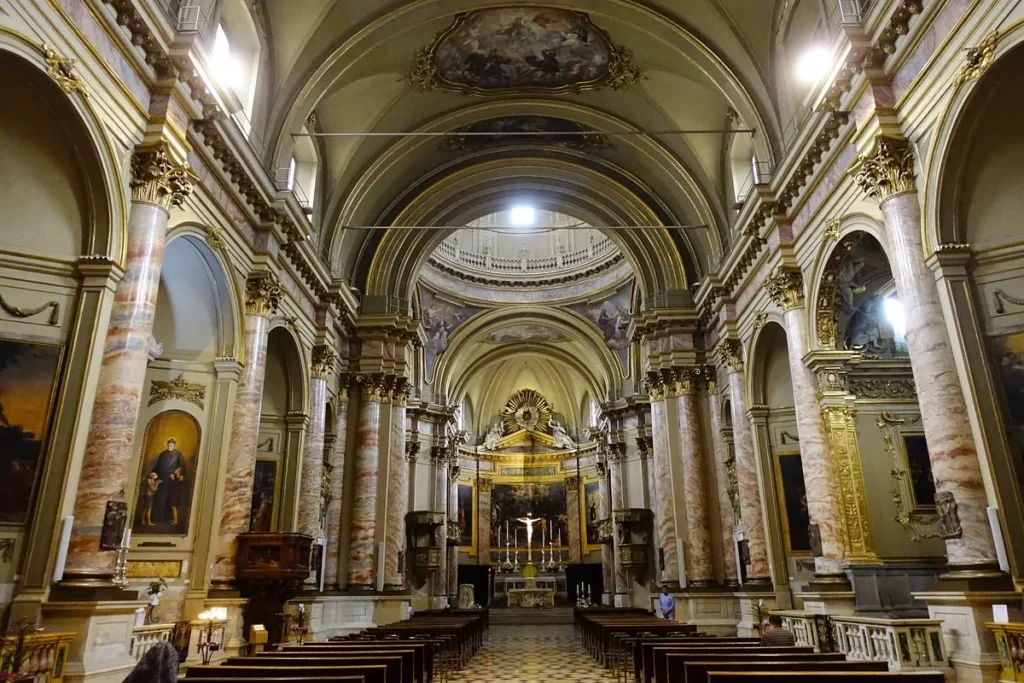
Architectural Structure
The interior of the Basilica of Sant’Alessandro alla Colonna follows a Latin cross plan, a traditional layout in Christian ecclesiastical architecture. The single central nave is flanked by four side chapels on each side, creating a rhythm of spatial progression toward the main altar. A shallow transept, which does not extend beyond the width of the side chapels, intersects the nave and supports the weight of a large, centrally placed dome, emphasizing the vertical axis of the church and enhancing its sense of sacred elevation.
Altars and Significant Artworks
Throughout the Basilica of Sant’Alessandro alla Colonna, the altars are adorned with a remarkable collection of sacred artworks, spanning from the 16th to the 20th century. These pieces, created by renowned artists, not only serve a devotional purpose but also reflect the evolution of religious art in the Bergamo region. On the left side chapels, the third altar features the Sacred Heart by Trento Longaretti (1959), a modern interpretation that conveys deep spiritual sentiment while remaining rooted in traditional iconography. The fourth altar houses Laying of the First Stone of the Temple by Enea Salmeggia (1621), a painting that symbolizes the foundational moment of the church, rendered with solemnity and grace. On the right side, at the second altar, stands Saint Joseph with the Child and Saints Catherine of Alexandria and Francis de Sales by Ponziano Loverini, a richly detailed 19th-century work that exemplifies the devotional style of the period, combining warmth, realism, and theological symbolism. These works collectively contribute to the basilica’s artistic and spiritual richness, offering visitors a journey through centuries of faith-inspired creativity.
Presbytery and Transepts
The presbytery, located behind the main altar, features the powerful Martyrdom of Saint Alexander by Enea Salmeggia (1623). This intense oil on canvas captures the dramatic sacrifice of the basilica’s patron saint with reverence and solemnity, anchoring the spiritual focus of the space. In the left transept, the Assumption of the Virgin by Romanino (1540–1545) stands as a luminous altarpiece commissioned by the council of the Consortium of Sant’Alessandro. The work depicts the Madonna’s heavenly ascent in radiant tones, reinforcing the basilica’s long-standing Marian devotion. On the opposite side, the right transept hosts Glory of Saints Peter, Paul and Christopher by Gian Paolo Cavagna (1607), a vivid and color-rich composition that embodies the fervor and dignity of early Christian martyrdom, emblematic of 17th-century Bergamasque artistry.
Early 17th-Century Masterworks
Among the basilica’s most treasured artistic ensembles are three monumental canvases painted in 1621 by Bergamo’s leading artists of the time. Miracle of the Flowers Born from the Blood of Saint Alexander by Gian Paolo Cavagna offers a striking visual narrative of transformation through martyrdom, blending legend and miracle. Laying of the First Stone of the Temple by Enea Salmeggia, located at the fourth altar on the left, symbolically reflects the church’s foundational mission and spiritual authority. Meanwhile, Saint Grata Presents to Her Father the Flowers Bloomed from the Blood of the Martyr by Francesco Zucco captures a deeply emotional scene rooted in local legend, blending piety with poignant storytelling. Together, these works mark a high point in early 17th-century religious painting in Bergamo.
Wooden Choir and Carvings
The wooden choir of the basilica is a remarkable example of Baroque craftsmanship. It consists of 28 finely carved stalls, arranged in a semicircle along the apse. The stalls are adorned with zoomorphic figures, including lions’ heads and birds’ bodies, symbolizing spiritual guardianship and nature’s homage to divinity. These wooden works were crafted by Prata Alessio, who also created the organ case and pulpits. However, in 1780, these latter elements were replaced with new pieces by Antonio Francesco Caniana, in keeping with the evolving artistic style of the late 18th century.
Sacristy
The sacristy of the Basilica of Sant’Alessandro alla Colonna preserves a remarkable collection of sacred art, offering a quieter, more intimate space for reflection and artistic appreciation. Among its treasures is the emotionally powerful Lamentation over the Dead Christ (184 × 184 cm) by Lorenzo Lotto, where the lifeless body of Christ lies at the center, cradled by Saint John as the Virgin Mary collapses in anguish—a deeply moving composition recently restored in 2023 by the Creberg Foundation of Bergamo. Another masterpiece is the Assumption of the Virgin (450 × 270 cm) by Romanino, which portrays the Madonna’s ascent into heaven, illuminated by divine light as her stunned disciples look on in vibrant, expressive colors. The Virgin Adoring the Child (129 × 92 cm) by Alessandro Bonvicino (Moretto) is set against a refined Renaissance backdrop of marble, terracotta, and triple lancet windows, grounding the sacred in architectural beauty, while a straw roof subtly recalls the humble origins of the Nativity. Finally, Madonna of the Squirrel (180 × 72 cm) by Giovanni di Giacomo Gavazzi, painted in 1512 and influenced by the Bellini school, presents a tender and introspective scene of the seated Madonna with the Child, later enhanced by the addition of two angelic figures. These works together form a hidden gallery of devotion, showcasing the depth of spiritual and artistic tradition within the basilica’s sacred walls.
Pipe Organs and Bell Tower
The Basilica of Sant’Alessandro alla Colonna holds a long-standing musical tradition, marked by the presence of historically significant pipe organs. The first recorded organ was installed in 1718 by Gregorio and Antonio Bossi, a father and son team from Como who had settled in Borgo Canale. This instrument, first played on February 24th, was not a replacement but a new addition following the church’s renovation completed in 1715. Today, the basilica is home to two remarkable organs built by the esteemed Serassi family. The main organ (Opus 193–194), constructed in 1781, is situated in the apse on either side of the main altar and features an unusual underground mechanical transmission that connects the Third Organ in the left choir to the console in the right choir. The second instrument, Opus 376, was installed in 1844 in the Chapel of the Madonna del Patrocinio and complements the basilica’s rich musical ambiance. Above, the bell tower, which rises high above the church and contains 169 steps, opens to the public during the feast day of Saint Alexander, offering panoramic city views. The tower hosts a majestic carillon of 12 bells in A2, one of the largest in Lombardy. Of these, 10 bells form the major scale of A2 and 2 bells the major scale of B2. The original 8 bells were cast in 1905 by the Pruneri Foundry of Grosio, with an additional 4 bells added in 1951 by the Ottolina Foundry of Seregno. This remarkable musical heritage continues to resonate through the basilica, linking centuries of liturgical tradition with artistic and acoustic excellence.
Feast Day
Feast Day : 26th August
The feast day of Saint Alexander of Bergamo, the patron saint of the city and of the Basilica of Sant’Alessandro in Colonna, is celebrated annually on August 26th. This date commemorates the martyrdom of Saint Alexander in the year 303 AD and has been officially recognized as a citywide celebration in Bergamo since 1658.
The feast includes religious ceremonies, processions, and special masses, with key events held both at the basilica and the cathedral in Bergamo Alta, including a solemn Mass presided over by the Bishop of Bergamo and a city-wide bell concert.
Church Mass Timing
Monday : 07.30 AM, 6:00 PM.
Tuesday : 07.30 AM, 6:00 PM.
Wednesday : 07.30 AM, 6:00 PM.
Thursday : 07.30 AM, 6:00 PM.
Friday : 07.30 AM, 6:00 PM.
Saturday : 6:00 PM.
Sunday : 08.00 AM, 09.00 AM, 10.00 AM, 10.30 AM, 12.00 PM, 06.00 PM.
Church Opening Time:
Monday : 7:00 am – 7:00 pm.
Tuesday : 7:00 am – 7:00 pm.
Wednesday : 7:00 am – 7:00 pm.
Thursday : 7:00 am – 7:00 pm.
Friday : 7:00 am – 7:00 pm.
Saturday : 7:00 am – 7:00 pm.
Sunday : 7:00 am – 7:00 pm.
Contact Info
Basilica of Sant’Alessandro in Colonna
Via Sant’Alessandro, 35, 24122 Bergamo BG, Italy
Phone : +39035248022
Accommodations
Connectivities
Airway
Basilica of Sant’Alessandro in Colonna, Bergamo, Italy, to Il Caravaggio Int’l Airport (BGY), distance between 12 min (5.4 km) via Via Autostrada.
Railway
Basilica of Sant’Alessandro in Colonna, Bergamo, Italy, to Piazzale Guglielmo Marconi, distance between 8 min (1.3 km) via Viale Papa Giovanni XXIII.



